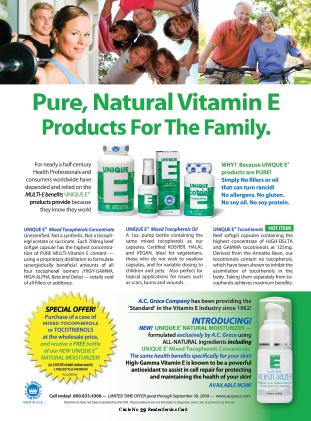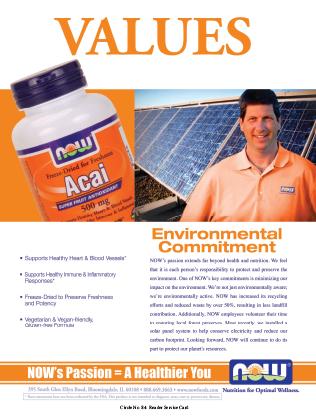Vitamin E supplements are about the size of a dime, but their health benefits are far greater than their stature. This tiny, fat-soluble vitamin offers multifaceted benefits and is an essential part of maintaining cell growth, cognitive ability and reducing free radical damage.
Vitamin “E” for Vitality
If your customers ask, “Should I be taking vitamin E supplements?” the answer should be an emphatic “Yes,” if they want to promote eye, heart, mental and skin health. Unsure about the dosage? Most adults should take 400 IUs or 1,000 mg of vitamin E daily (1).
So, just what is vitamin E and how does it work? Vitamin E is comprised of eight different isomers: alpha, beta, gamma and delta tocopherols and alpha, beta, gamma and delta tocotrienols.  Says one vitamin E specialist, “Although tocopherols and tocotrienols both exist in nature, plants differ widely in their vitamin E proportions and tocopherols are the most abundant form utilized by humans” (2).
Says one vitamin E specialist, “Although tocopherols and tocotrienols both exist in nature, plants differ widely in their vitamin E proportions and tocopherols are the most abundant form utilized by humans” (2).
Tocopherols are a class of chemical compounds, with many having vitamin E activity. Tocopherols are said to have more antioxidant, anti-cancer and anti-inflammatory properties than their counterpart, tocotrienols (2). On the other hand, tocotrienols are most beneficial for cardiovascular health, maintaining healthy cholesterol levels and diabetes support (2). When taking a mixed tocopherol/tocotrienol supplement, this one-two punch is readily absorbed into the body and helps address various health ailments. For more targeted support, some manufacturers separate out tocopherols and tocotrienols and sell them individually. See sidebar, “Tocotrienols versus Tocopherols: The Benefits of Tocotrienols,” for more information.
Vitamin E to the Rescue
Heart Strength. Heart disease is the number one cause of death among Western nations and usually develops slowly and advances without warning (3). In those affected by heart disease, artery walls become damaged or injured by free radicals. Over time, the damaged arteries may become clogged with cholesterol and fat particles. Thus, smooth muscle cells start to grow on artery walls, and form a sticky plaque. 
The cause of heart disease can be attributed to many factors, including a lack of vitamin E. Mounting evidence suggests that vitamin E is great for maintaining heart function (3). It is said to slow the formation of arterial plaque by stopping the oxidation of LDL cholesterol, which may reduce heart disease.
Case in point, researchers at Harvard University reported in the New England Journal of Medicine that vitamin E supplements drastically deflated the risk of coronary heart disease in both men and women (3).
Taking things a step further, The Lancet published research in which 2,000 heart disease patients took either 400 or 800 IUs of natural vitamin E or placebos daily for 18 months. The vitamin E group had 77% fewer cases of non-fatal heart attacks in contrast to the placebo group (3). Vitamin E’s benefits were apparent in just six-and-a-half months. These aforementioned data lead the study’s researchers to conclude that vitamin E is more efficacious in controlling heart attacks than aspirin and cholesterol-lowering drugs.
Mental Dexterity. Vitamin E is also great for slowing the progression of Alzheimer’s disease and is a crucial part of maintaining the brain’s cognitive abilities (4). The brain has huge amounts of polyunsaturated fatty acids, which makes it prone to free radical damage. The bad news is that when one brain cell is damaged, it can trigger a reaction in which many fatty acid cells in the brain also become damaged (3). The good news is that vitamin E can help.
University of California researchers spearheaded a study supporting this evidence, which was published in the New England Journal of Medicine. Some 341 Alzheimer’s disease patients with moderate symptoms were separated into four groups. Each patient was treated with a placebo, the drug Selegiline, vitamin E or a combination of vitamin E and Selegine for two years (4). Patients who took vitamin E were able to slow the progression of the disease. As a result of this finding, the American Psychiatric Association updated its guidelines for treating Alzheimer’s and other forms of dementia to include vitamin E (4).
Skin Fitness. On a daily basis, the skin is subjected to ultraviolet (UV) radiation from sunlight and pollutants from the environment, which produce damaging free radicals. Over time, sun exposure and resulting damage can cause skin cancer. According to the American Cancer Society, nearly half of all men and more than one-third of all women in the United States will be diagnosed with cancer during their lifetimes.
But, research has revealed that both internal and external absorption of vitamin E safeguards the skin from the damage that may result from excessive exposure to UV rays. It also increases the levels of protective antioxidants in skin cells and reduces immune system suppression, which also may be caused by sunlight exposure (3). Adding to the plethora of benefits, vitamin E impedes wrinkles by blocking Kinase C. Kinase C is an enzyme that promotes the breakdown of collagen, which is a central skin protein (3). The aging process along with air pollution causes this disruption, but vitamin E provides a sizable degree of protection against it.
Last, clinical tests have proven that vitamin E is an excellent source for healing and minimizing the appearance of cuts, scrapes and scars on the skin’s surface. Acne (an inflammatory disease marked by pimples) is an example of a skin condition that can be alleviated as a result of taking this vitamin. According to nutritionist Jack Challem, “You can also pop vitamin E capsules with a needle and dab the oil on minor household burns and cuts after a scab is formed“ (3). Vitamin E also has been shown to be helpful as a moisturizer for dry skin.
Eye Wellness. As previously discussed, solar radiation can be blamed for a bevy of problems, and the sun’s impact on the eyes is no different. Vitamin E (alpha tocopherol) is layered across the retina. However, it is essential to protect the light receptor cells at the back of the eyes, where there are large amounts of unsaturated fats. For all intents and purposes, researchers conclude that vitamin E can help with age-related macular degeneration.
They note that “the spot where the retina is the thinnest is where macular degeneration begins” (5). The eradication of photoreceptor cells in the retina has been directly related to the accumulation of lipofuscin (or deposits) in the retinal cleansing cells. As lipofuscin in the eyes increases, melanin (a brown pigment that protects the eyes) is displaced. Take note that lipofuscin deposits may be an early sign of macular degeneration, which is also known as Stargardt’s disease. “These deposits can, in turn, impair the transfer of nutrients and gases (oxygen) to the light receptor cells,” says author Bill Sardi (6).
Vitamin E is also said to prevent retinal detachment, which usually follows surgery on the vitreous humor gel or retina. Though more research is needed, it is believed to reduce the risk of cataracts (6).
Sources of Vitamin E
Do any foods contain vitamin E? Well, not surprisingly, it is commonly found in egg yolks, green, leafy vegetables, nuts, vegetable oils and whole grains. But, dietary sources may not provide all we need. Rather, “food supplements provide all the forms of vitamin E, the alpha, beta, delta, and gamma forms of tocopherol and tocotrienols” that we need to be healthy (6). WF
References
1. Reference.com, www.reference.com/search?q=Tocotrienols, accessed June 1, 2009.
2. A.C. Grace Company , Unique E product brochure.
3. J. Challem and M. Diane Smith, User’s Guide to Vitamin E (Basic Health Publications, Laguna Beach, CA, 2002).
4. A. Papas, The Vitamin E Factor (HarperCollins Publishers, New York, NY, 1999).
5. I.M. Price and L. Comac, Coping with Macular Degeneration (Avery Publishing, New York, NY, 2000).
6. B. Sardi, User’s Guide to Eye Health Supplements (Basic Health Publications, Laguna Beach, CA, 2003).
|
Tocotrienols versus Tocopherols: The Benefits of Tocotrienols Although Herbert McLean Evans discovered vitamin E in 1922 as a vital nutrient to prevent birth defects, it was not until the late 1950s that the scientific community became aware that the vitamin E family consists of two major subgroups, namely tocopherols and tocotrienols. Each subgroup also contains four structurally and chemically diverse molecules (alpha-, beta-, gamma-, delta-): four tocopherols and four tocotrienols. References |
Published inWholeFoods Magazine, August 2009









